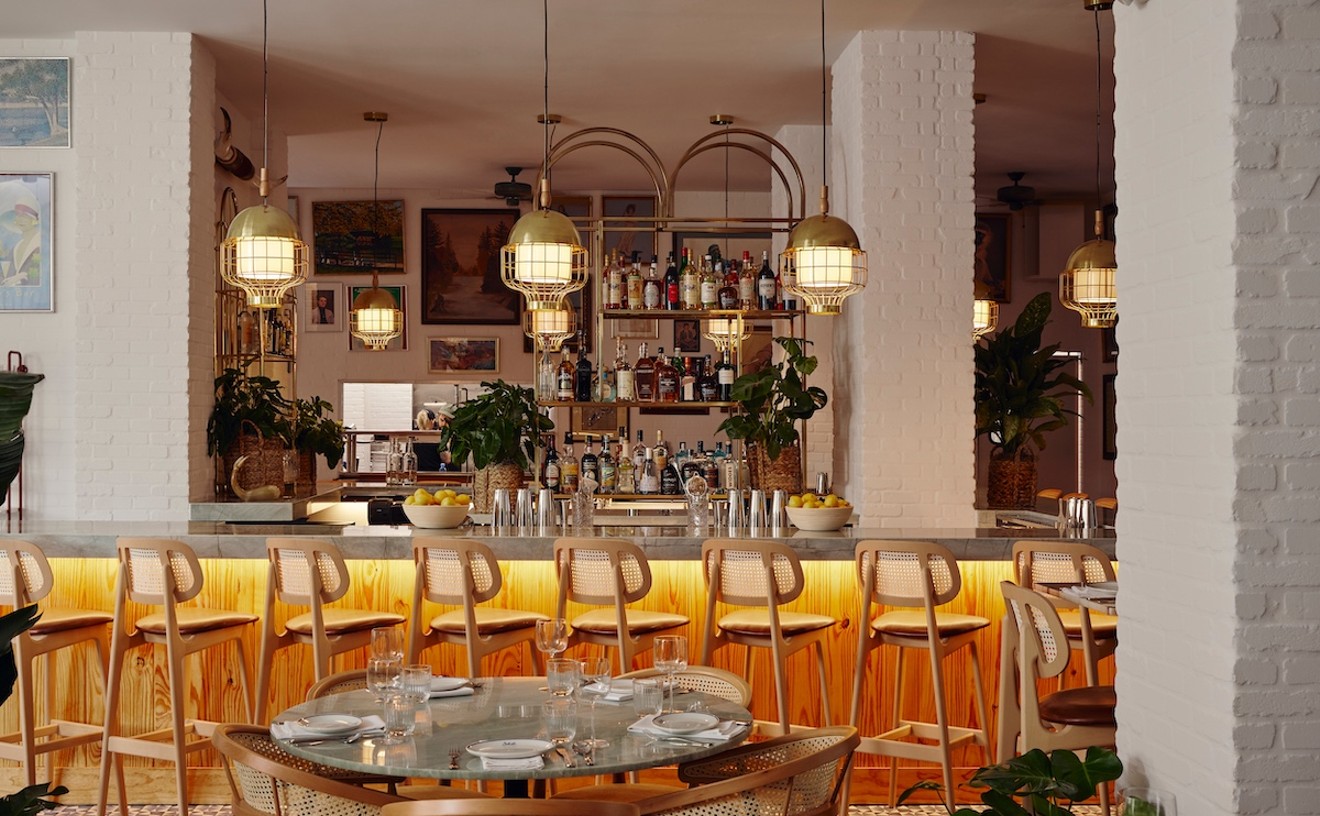For this season's six shows, though, The Restaurant reverted to a theme as old as Italy's spaghetti westerns: Good Guy Chef with a dream -- that would be the appealingly elfin but tough young DiSpirito seeking to elevate his Art through disseminating Mom's meatballs to the world, regardless of cost -- going up against money-loving, Art-hating Bad Guy Financier. That would be Miami homeboy Jeffrey Chodorow of China Grill Management, who bankrolled Rocco's.
This season DiSpirito screwed up his hero role royally, morphing on-camera into a self-absorbed jerk who spent way more time salivating over female diners than he did creating mouthwatering dinners; restaurant reviewers savaged the kitchen. Chodorow, however, played his part of Big Bucks Banker to perfection, especially in his sinister search for a suitable replacement chef. In a nutshell, all the candidates were, like Rocco, Italian-American hunks whose names began with an "R." The latter was perhaps coincidental, but as the financier noted when interviewing a chef nicknamed Red, it meant the restaurant's monogrammed plates wouldn't have to be replaced.
As of The Restaurant's final episode earlier this month, all America knows that candidate Mark Randazzo, cruiserweight boxer-turned-chef/owner of Randazzo's Little Italy, coulda been a contender had the series continued. Every dish at a filmed tasting at the Gables eatery elicited orgasmic cries, making it clear that Chodorow felt Randazzo's is the capital R restaurant Rocco's should have been.
Worried that the national publicity will make it impossible to get a table? That's already been the case since Randazzo's opened last year. Especially on weekends -- when no reservations are taken -- the place has regularly been packed, with lines halfway down the block, within ten minutes of opening for dinner at 6:00. What does Randazzo's have that near-empty neighboring eateries along the Gables' restaurant row don't (aside from its charismatic proprietor, who obviously escaped the boxing ring before his very cute nose got flattened)? Here's what: a dining space festooned with illuminated plastic grapes; a circa-1955 music tape that plays "That's Amore" at least once or twice every hour; and lotsa red sauce -- classic, comforting, old-fashioned Italian-American soul food.
Starters are big enough for four to share, and the size of the entrées makes the whole concept of appetizers ridiculous. A couple of salads are nevertheless must-haves. Just don't expect light-bite rabbit food. Randazzo's signature salad is a piled-high platter of protein -- diced salami, Provolone, Gorgonzola -- supplemented with hot pepperoncini, roasted red peppers, tomatoes, red onion, cucumbers, celery, and chickpeas, with just a touch of iceberg lettuce on the bottom. Coated with a properly proportioned, not-too-vinegary homemade dressing, it's formidable food.
It's inconceivable to try bread salad Sinatra in the same meal, but the filling dish was worth a special trip back. In Italy, where this peasant dish was originally a way to utilize stale bread, the vinaigrette-soaked cubes were supplemented with basil and whatever veggies were ripe (most often tomatoes, plus onion, cucumbers, and peppers). Randazzo's opulent, more meaty take was minus the cukes and peppers, but included copious amounts of salami and Provolone.
As at Rocco's, the pièce de résistance at Randazzo's is Mom's meatballs. These are served on their own, as an appetizer, or garnishing four different pasta dishes -- though "garnish" hardly seems appropriate to describe meatballs the size of cannonballs. At many red-sauce joints, the meatballs are also the density of cannonballs, owing to overworking the meat, but Randazzo's are juicy and soft, just firm enough to hold their shape without crumbling at the first touch of a fork. They're nicely spiced, too.
For traditionalists longing for food that tastes the way Italian food used to taste in America, the required pasta is spaghetti with Sunday gravy. Translation: truly pumped spaghetti 'n' meatballs, not a dish one would ever find in Italy, but the cornerstone of the menu at any home-style Italian/American restaurant (or family Sunday dinner). The version served up by Randazzo, who learned to cook from his grandmother in Chicago's Little Italy, features a mountain of pasta slightly softer than al dente and sauced with intense tomato "gravy" that has been concentrated by hours of simmering. Several logs of spicy homemade sausage jack up the dish's protein component and rich taste.
A completely different kind of red sauce came on spaghetti puttanesca, which translates as "whores' spaghetti." With a schedule that allowed for only minutes, not hours, between clients, Rome's prostitutes devised a sauce whose richness came from pungent ingredients rather than long cooking. Randazzo's version has all the authentic savories -- olives, capers, and anchovies -- plus onions, plentiful garlic slices, and white wine. The central tomatoes were two kinds, the fresh ones (halved cherry tomatoes) cited on the menu, plus strips of what looked and tasted like either canned San Marzanos or roasted plum tomatoes. The sauce's consistency was lighter than the Sunday gravy but had been ladled on generously, so no pungency was lacking.
What seafood lover could resist linguine with clams described as "so fresh one of them might jump up and bite you on the nose"? The small littlenecks topping the pasta did indeed taste as though they'd communed with the fishes only a short while before. Sauce color is the diner's choice, and our white was a thin but flavorful reduced broth enriched by garlic, as well as additional clam meat (soft, so possibly from a can, but good).
Linguine with garlic and oil is a dish so simple, one would imagine it foolproof, but fools manage to screw it up in most restaurants, mainly by using inferior olive oil and jarred faux "fresh" garlic. Randazzo's linguine was terrific, with enough real garlic to repel vampires for weeks, and the added piquancy of chopped pepperoncini. As with all the pastas I tried, the linguine had been cooked about a minute longer than my personal preference, but was far from mushy.
Thinking that three hearty eaters could somehow manage to polish off one secondi, my party ordered veal Milanese Soprano, but it was hard to believe that the arugula and Parmesan-topped breaded chop that arrived at our table had come from a baby cow. It looked as though it had been cut from a full-grown brontosaurus. The leftovers made a wonderful meal -- for the following four days.
For dessert, the chef-written menu advises diners to "shut up and eat a cannoli, it's 10,000 calories, so what, you ain't a model!" The pastry's calorie count had probably been underestimated by half, and the fried shell enclosing its creamy, supersweet ricotta filling was, frankly, too tough to get through without a steak knife. But so what? Randazzo's ain't fine dining -- it's fun dining.










